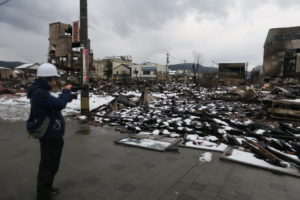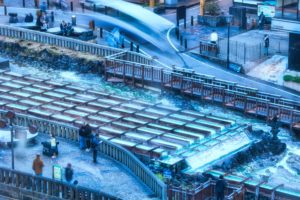
Why is water abundant in Gunma?
In the previous article, we explained the mountains that represent Gunma Prefecture, and in this post we would like to introduce the abundant gifts of water nurtured by these mountains. Thanks to the steep mountains and forests that cover two-thirds of the prefecture's land, there are abundant sources of water despite the low annual rainfall. For this reason, many hydroelectric power stations and artificial lakes have been built, and many people from other prefectures visit Gunma Prefecture to taste spring water. In this article, we would like to introduce some shooting spots and activities that make the most of this abundant water.
Ozegahara

Ozegahara, 6 km east to west and 2 km north to south, is one of the largest high altitude marshlands in Japan and was created over a period of 6,000-7,000 years. Wooden paths and benches have been built in the marshland, making it ideal for shooting rare nature up close and taking a relaxing stroll. Mountains of 2000 m altitude surround Ozegahara. Mt. Hiuchi, the highest peak in the Tohoku region, is on the east side, and the gently sloping Mt Shibutsu on the west side. Furthermore, Mt. Aizu Komagatake and Mt Tashiro offer magnificent views of the Ozegahara. This marshland area has also been designated a national park in order to protect the precious nature. It is a national special natural monument and a Ramsar Convention-listed wetland. The ecosystems and landscapes here are strictly protected and preserved, so as a fixer in Japan, I would like to advise you to take various precautions when shooting.
(Access.)
There are several entry points to the Oze area, such as Numayama pass and Ooshimizu, but we would recommend Hatomachitoge pass for its closeness to Ozegahara. On certain days between mid-May and early October, car access is restricted from the Hatomachitoge pass, so park at the Oze No.1 car park in Togura and take the shuttle bus. The Togura car park has 530 spaces and costs ¥1,000 per day. The journey from Tokyo to the Togura car park takes about 2 hours.
Address of Oze Parking Lot No. 1: 766 Tokura, Katashina, Tone District, Gunma
(Contact Information)
Oze Preservation Foundation
https://oze-fnd.or.jp/en/
Tel: +81 27 220 4431
Email: info@oze-fnd.or.jp
Fukiware Falls

On the way from Tokyo to Ozegahara is another scenic spot that makes the most of Gunma's water attractions: the Fukiware Falls. The waterfalls are 7 m high and more than 30 m wide, and the spray from the falls is referred to as the Niagara of the East. The waterfalls are so named because the soft bedrock of the river bed has been eroded, creating numerous cracks, the largest of which forms the waterfall, giving the appearance of a giant rock breaking apart. The waterfalls are academically valuable because of the erosion of the water and attract many visitors: in April and May, when the waterfalls are freshly green, they are dynamic waterfalls swallowing melting snow, and in autumn they are beautiful in the autumn colours of the leaves, combined with the beauty of the valley. The waterfalls can be filmed in a different way in each season. As a fixer I have seen many different Japanese waterfalls, and this Fukiware Falls is one of the most beautiful.
(Access and Contact Information)
Address: Tonemachi Okkai, Numata, Gunma
https://www.numata-kankou.jp/fukiwarenotaki/
Numata City Hall, Tourism Exchange Section
Tel: +81 278 23 2111
Ski & Snowboarding

Gunma Prefecture, with its abundance of water and below zero temperatures in winter, is dotted with more than 20 ski resorts of various sizes. All are accessible from Tokyo in about two hours and can be reached on a day trip. They are characterised by high quality snow. Many of the slopes are suitable for beginners in skiing and snowboarding and will accommodate various types of filming. The Katashina area, one of the Kanto region's heaviest snowfall areas, is home to big slopes such as Marunuma Kogen Ski Resort and White World Oze Iwakura. The Minakami area is close to a highway exit, and ski resorts such as Norn Minakami and Tanigawadake Tenjindaira can be reached from Tokyo in about two hours. Gunma Prefecture's ski resorts, which offer both good accessibility from Tokyo and good snow quality, and as fixers in Japan, we highly recommend them as shooting locations.
(URL and Address of Ski Resorts)
Marunuma Kogen Ski Resort
https://www.marunuma.jp/winter/
Address: 4658-58 Higashiogawa, Katashina, Tone District, Gunma
White World Oze Iwakura
https://www.oze-iwakura.co.jp/ski/language/en/
Address: 609 Tsuchiide, Katashina, Tone District, Gunma
Norn Minakami
https://www.norn.co.jp/winter/english_ski_information/
Address: 479-139 Terama, Minakami, Tone District, Gunma
Tanigawadake Tenjindaira
https://www.tanigawadake-rw.com/tenjindaira/en/
湯檜曽湯吹山国有林, Minakami, Tone District, Gunma
Minakami: Mecca for water activities

Located in the northernmost part of Gunma Prefecture, Minakami is blessed with abundant water sources, including the Tone River, and is surrounded by mountains such as Mt. Tanigawa, one of Japan's most famous mountains. The town as a whole focuses on outdoor activities, with rafting and canyoning being particularly popular activities. It takes about one and a half hours to get there from central Tokyo by highway or Shinkansen bullet train, making it possible to take a day trip, and it is highly recommended.
In this article, we have presented about the water attractions of Gunma. Please look forward to my subsequent posts where I will let you know about the various attractions of this beautiful locations, such as hot springs, cultural attractions and gastronomy.
Please read othere articles featuring Gunma.
Gunma Part 1: 2,000m mountains just 1 hour or two from Tokyo
Gunma Part 2: Water, gift from the mountains
Gunma Part 3: Hot Spring Kingdom
Gunma Part 4: Other attractions


